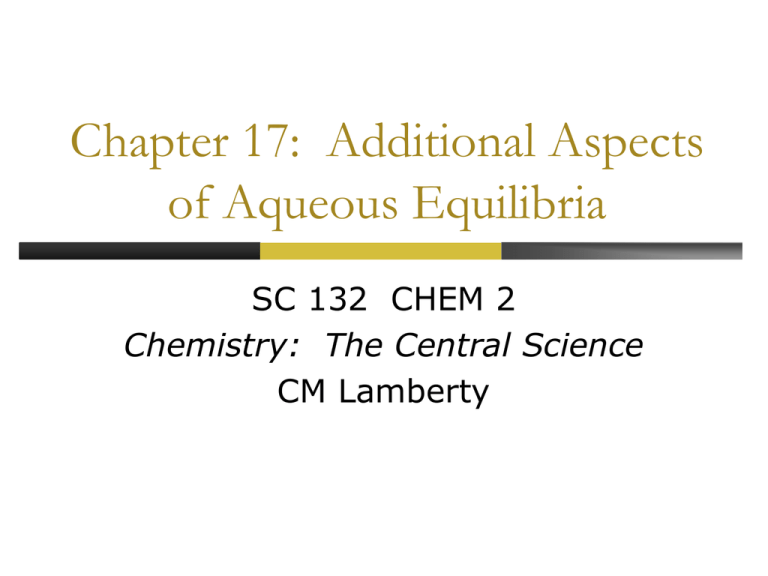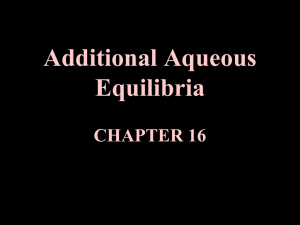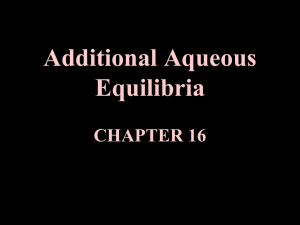Chapter 17 Additional Aspects of Aqueous Equilibria
advertisement

Chapter 17: Additional Aspects of Aqueous Equilibria SC 132 CHEM 2 Chemistry: The Central Science CM Lamberty The Common Ion Effect Consider the given equilibrium The extent weak acid, HA, dissociates to form H3O+ and determine pH is based on its Ka Until now in acid-base equilibria, we’ve only started with reactant What happens if we start with some acid/base AND some of its conjugate Think about LeChatelier’s Principle before you answer Buffers Solns composed of Initial concentration of weak species (acid or base) Initial concentration of its conjugate Main characteristics of buffers Lower dissociation percentage of the weak species (common ion effect) Resists changes to pH after addition of acid or base Key Buffer Components Consider the expression for Ka of a weak acid: If we solve for [H3O+], we get So, [H3O+] can only change as the buffer-component ration concentrations change Addition of acid or base changes both factors in the ratio, but the numerical value of the ratio changes very little! Calculating Buffer pH Practice PROBLEM: Calculate the pH of a buffer that consists 1.0M sodium phenolate (C6H5COONa) and 1.2M phenol (C6H5COOH) (pKa of phenol is 10.00) PROBLEM: What is the buffer component concentration ratio, [NO2-]/[HNO2], of a buffer that has a pH of 2.95 (Ka = 7.1x10-4 for HNO2) The Henderson Hasselbach Eqtn Remember, you NEVER have to use the Henderson-Hasselbach eqtn…you can always get the same info by constructing an ICE table Convenience of Henderson-Hasselbach: Get pH directly Simplifies buffer preparation problems Buffer Capacity and Buffer Range Buffer capacity is the ability to resist pH change. The more concentrated the components of a buffer, the greater the buffer capacity. The pH of a buffer is distinct from its buffer capacity. A buffer has the highest capacity when the component concentrations are equal. Buffer range is the pH range over which the buffer acts effectively. Buffers have a usable range within ± 1 pH unit of the pKa of its acid component. Buffer ()pH After H3O+ or OH- Addition There is an additional step to add to the calculation process! We must write the acid-base rxn b/t the H3O+ or OH- added and the buffer component it reacts with Then, we recalculate the concentrations of each buffer component Plug these values into ICE table & calculate what you’re being asked for Practice PROBLEM: Calculate the pH: (a) of a buffer solution consisting of 0.50M CH3COOH and 0.50M CH3COONa (b) after adding 0.020mol of solid NaOH to 1.0L of the buffer solution in part (a) (c) after adding 0.020mol of HCl to 1.0L of the buffer solution in part (a) Ka of CH3COOH = 1.8x10-5. (Assume the additions cause negligible volume changes. Preparing a Buffer 1. Choose the conjugate acid-base pair. 2. Calculate the ratio of buffer component concentrations. 3. Determine the buffer concentration. 4. Mix the solution and adjust the pH. Acid-Base Titrations Controlled neutralization rxns can be carried for a number of purposes 1. 2. Determine concentration of an unknown acid or base Determine the Ka value of an unknown acid or base Our job will be to calculate pH values after the addition of various volumes of added acid or base Acid/Base Titration Curves • • • You are dispensing one soln (from a buret) into a known quantity of another soln (in an E. flask) or viceversa Goal is to calculate pH after the addition of some amt of titrant Big Questions: 1. Which species are in soln @ indicated point of titration? 2. Do these species affect pH? If so, how? a. b. c. Only acids, bases, and conjugates of WEAK acids/bases influence pH What type of titration is this (SA or WA/SSB or WB) Is there an equil involved that must be taken into account? Titrating Strong with Strong 4 main parts of titration curve: 1. 2. 3. 4. Before any titrant added – Calculate pH from complete dssn of starting material – pH dependent on if starting material is an acid or base Some titrant added, before EqP – See how much starting material used up and what’s left – Calculate pH from complete dssn of left over starting material At EqP – No acid/base left; only have salt – Since both are strong species, salt DOES NOT affect pH * pH = 7 @ EqP as salt of SA & SSB rxn is NEUTRAL Past EqP – Now have excess titrant – Determine amt of excess titrant – Calculate pH from complete dssn of excess titrant Steps to Titration Calculations Before beginning: Always determine the equivalence point in the titration There are always 2 parts to a titration calculation problem after some titrant has been added: 1. 2. Write the acid-base reaction to determine which species will be left in the container that affect pH Write the reaction of the leftover acid or base with water to determine [H3O+] or [OH-] in order to calculate pH If species is weak, it will be an equilibrium calculation (and probably a buffer) If species is strong, just calculate its concnetration & take log Practice Calculate the pH of a solution if 25.00mL of 0.200M HBr is mixed with 12.50mL of 0.100 M Ba(OH)2 After 25.00mL of 0.100M Ba(OH)2 After 50.00mL of Ba(OH)2 Equilibria of Slightly Soluble Ionic Compounds For the hypothetical compound, MpXq (s) At equilibrium Qsp = [Mn+]p [Xz-]q = Ksp The magnitude of Ksp is a measure of the compound’s solubility in H2O • Lower Ksp (more negative exponent) means lower solubility Practice PROBLEM: Write the ion-product expression for each of the following: (a) Magnesium carbonate (c) Calcium phosphate (b) Iron (II) hydroxide (d) Silver sulfide Ksp Calculations Again 2 basic types: 1. 2. Calculate solubility (aka “X”) if Ksp is known May require additional steps depending on what youre being asked for Calculate Ksp if solubility (X) is known Remember, must convert all concentrations to molarity Because reactant is solid, ICE table starts under the arrow Common ion problems occur when soln starts w/ one of the solid’s ions to begin with End result like in buffer is decreased dissociation (so decreased solubility Practice PROBLEM:(a) Lead (II) sulfate is a key component in lead-acid car batteries. Its solubility in water at 250C is 4.25x10-3g/100mL solution. What is the Ksp of PbSO4? (b) When lead (II) fluoride (PbF2) is shaken with pure water at 250C, the solubility is found to be 0.64g/L. Calculate the Ksp of PbF2. PROBLEM: Calcium hydroxide (slaked lime) is a major component of mortar, plaster, and cement, and solutions of Ca(OH)2 are used in industry as a cheap, strong base. Calculate the solubility of Ca(OH)2 in water if the Ksp is 6.5x10-6. PROBLEM: In Sample Problem 19.6, we calculated the solubility of Ca(OH)2 in water. What is its solubility in 0.10M Ca(NO3)2? Ksp of Ca(OH)2 is 6.5x10-6. PROBLEM: A common laboratory method for preparing a precipitate is to mix solutions of the component ions. Does a precipitate form when 0.100L of 0.30M Ca(NO3)2 is mixed with 0.200L of 0.060M NaF? Practice PROBLEM: An environmental chemist needs a carbonate buffer of pH 10.00 to study the effects of the acid rain on limsetone-rich soils. How many grams of Na2CO3 must she add to 1.5L of freshly prepared 0.20M NaHCO3 to make the buffer? Ka of HCO3- is 4.7x10-11. Factors Affecting Solubility Temperature Presence of common ions Common Ion Effect Solubility of slightly soluble salt is DECREASED by the presence of a second solute that furnishes a common ion pH of solution Addition of strong acid (H3O+) will INCREASE the solubility of an insoluble salt if Anion is conjugate base of a weak acid Think about LeChatelier’s Principle Factors Affecting Solubility Presence of Complex Ions Metal ions can act like Lew acids toward H2O or other Lewis bases Both solubility of metal salt and metal ion and Lewis base must be added together Need the formation constant (Kf) for complex ions Solubility of metal salts increases in the presence of suitable Lewis bases (NH3, CN-, OH-) Amphoterism Amphoteric oxides and hydroxides are substances soluble in SA and SB because they can act as either acid or base Al+3, Cr+3, Zn+2, Sn+2 Dissolve in acidic soln b/c contain basic anions Dissolve in base b/c form complex ions Precipitation and Separation of Ions Use Q to determine direction of reaction Q > Ksp ppt occurs until Q=Ksp Q= Ksp, equilibrium Q < Ksp, solid dissolves until Q=Ksp Selective ppt of ions Way of separating ions form one another Qualitative Analysis Practice PROBLEM: Write balanced equations to explain whether addition of H3O+ from a strong acid affects the solubility of these ionic compounds: (a) Lead (II) bromide (b) Copper (II) hydroxide (c) Iron (II) sulfide Free-for-all Practice Calculate the pH, pOH, [H3O+], and [OH-] of a solution that is 0.0579M Ba(OH)2 Calculate the pH of a buffer solution that is 0.500M NH3 and 0.675M NH4Cl. Ka for NH4+ is 1.75x10-5 If 1.36mg/L AgBr produces a saturated soln, determine its solubility product constant. What would its molar solubility be in a solution of 0.0750M MgBr2? What is the maximum amount of solid sodium sulfate that can be added to 1.00 L of 0.0020 M Ca(NO3)2 before precipitation of calcium sulfate begins? Ksp = 2.4 10-5 for calcium sulfate A 0.050 M solution of the weak acid HA has [H3O+] = 3.77 10-4 M. What is the Ka for the acid? What is the solution pH? Free-for-all Practice Buffer solutions with the component concentrations shown below were prepared. Which of them should have the lowest pH? A. [CH3COOH] = 0.25 M, [CH3COO-] = 0.25 M B. [CH3COOH] = 0.75 M, [CH3COO-] = 0.75 M C. [CH3COOH] = 0.75 M, [CH3COO-] = 0.25 M D. [CH3COOH] = 0.25 M, [CH3COO-] = 0.75 M E. [CH3COOH] = 1.00 M, [CH3COO-] = 1.00 M What will be the effect of adding 0.5 mL of 0.1 M NaOH to 100 mL of an acetate buffer in which [CH3COOH] = [CH3COO-] = 0.5 M? A. The pH will increase slightly. B. The pH will increase significantly. C. The pH will decrease slightly. D. The pH will decrease significantly. E. Since it is a buffer solution, the pH will not be affected. Free-for-all Practice Which of the following has the highest buffer capacity? A. 0.10 M H2PO4-/0.10 M HPO42B. 0.50 M H2PO4-/0.10 M HPO42C. 0.10 M H2PO4-/0.50 M HPO42D. 0.50 M H2PO4-/0.50 M HPO42E. They all have the same buffer capacity. Which of the following acids should be used to prepare a buffer with a pH of 4.5? A. HOC6H4OCOOH, Ka = 1.0 10-3 B. C6H4(COOH)2, Ka = 2.9 10-4 C. CH3COOH, Ka = 1.8 10-5 D. C5H5O5COOH-2, Ka = 4.0 10-6 E. HBrO, Ka = 2.3 10-9 Free-for-all Practice A. B. C. D. E. According to Brønsted and Lowry, which one of the following is not a conjugate acid-base pair? A. H3O+/OHB. CH3OH2+/CH3OH C. HI/ID. HSO4-/SO42E. H2/HThe acid dissociation constant Ka equals 1.26 10-2 for HSO4- and is 5.6 10-10 for NH4+. Which statement about the following equilibrium is correct? HSO4-(aq) + NH3(aq) SO42-(aq) + NH4+(aq) The reactants will be favored because ammonia is a stronger base than the sulfate anion. The products will be favored because the hydrogen sulfate ion is a stronger acid than the ammonium ion. Neither reactants or products will be favored because all of the species are weak acids or bases. The initial concentrations of the hydrogen sulfate ion and ammonia must be known before any prediction can be made. This reaction is impossible to predict, since the strong acid and the weak base appear on the same side of the equation.







